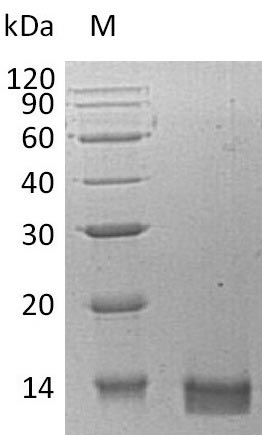Introducing our Recombinant Human CXCL14 protein, a crucial tool for researchers in the field of immunology. This C-X-C motif chemokine 14, known as CXCL14, MIP2G, NJAC, and SCYB14, is expressed in E. coli and covers the 35-111aa expression region of the full-length mature protein. The tag-free protein is provided as a lyophilized powder for straightforward reconstitution with sterile water or buffer, ensuring a variety of experimental applications.
Quality and performance are our top priorities, and our Recombinant Human CXCL14 protein displays a purity of >95% as determined by SDS-PAGE and HPLC analysis. Additionally, endotoxin levels are controlled below 1.0 EU/µg, as determined by the LAL method. The protein exhibits biological activity as assessed by its ability to induce calcium flux of prostaglandin E2 treated THP1 human acute monocytic leukemia cells, with an ED50 typically in the range of 1-10 ng/mL.
CXCL14 has been widely investigated for its roles in immune regulation, tumor progression, and cancer[1]. Studies have revealed its chemotactic functions on monocytes and dendritic cells[2] and its tumor-suppressive properties in several cancer types[3]. This highlights the significance of CXCL14 in immune system research and its potential as a therapeutic target for immune-related diseases and cancer.
References:
1. Hara T, et al. Identification of a chemotactic ligand for CXCR1 and CXCR2 in human osteosarcoma cells. Biochem Biophys Res Commun. 2009;386(4): 694-9.
2. Hromas R, et al. Cloning of BRAK, a novel divergent CXC chemokine preferentially expressed in normal versus malignant cells. Biochem Biophys Res Commun. 1999;255(3): 703-6.
3. Tanegashima K, et al. The Chemokine CXCL14 suppresses the tumorigenicity of hepatocellular carcinoma cells. Int J Cancer. 2013;132(4): 949-60.






